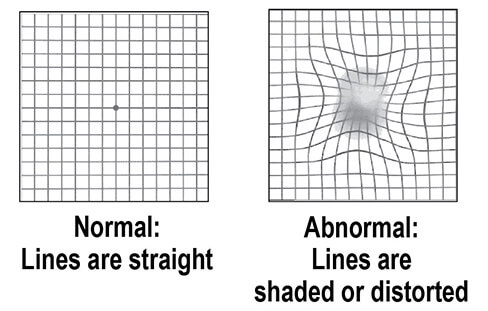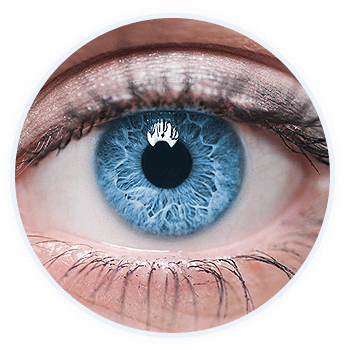Macular Degeneration (or AMD) is a group of diseases characterized by a breakdown of the macula. The macula is a small area at the back of the eye (retina) that allows us to see fine details clearly. When the macula doesn’t function correctly, we experience blurring or darkness in the center of our vision.
Macular degeneration affects both distance and close vision and can make some activities, like driving, reading or threading a needle, difficult or impossible. Although macular degeneration reduces vision in the central part of the retina, it does not affect the eye’s side or peripheral vision. For example, you could see the outline of a clock but not be able to tell what time it is. Macular degeneration can cause different symptoms in different people. Sometimes only one eye loses vision while the other eye continues to see clearly for many years.
The following are some common ways vision loss is detected:
- Words on a page look blurred or dark, or empty area appears in the center of vision.
- Straight lines look distorted as in this diagram.

The two most common types of age-related macular degeneration are dry (atrophic) and wet (exudative).
Dry Macular Degeneration
Dry AMD is an early stage of the disease and may result from the aging and thinning of macular tissues, depositing of pigment in the macula or a combination of the two processes. Dry macular degeneration is diagnosed when yellowish spots known as drusen begin to accumulate in and around the macula. Gradual central vision loss may occur with dry macular degeneration but is not nearly as severe as with wet AMD.
Wet Macular Degeneration
In about 10 percent of cases, dry AMD progresses to the more advanced and damaging form of the eye disease. With wet macular degeneration, new blood vessels grow (neovascularization) beneath the retina and leak blood and fluid. This leakage causes permanent damage to light-sensitive retinal cells that die off and create blind spots in the central vision. Neovascularization, the underlying process causing wet AMD and abnormal blood vessel growth, is the body’s misguided way of attempting to create a new network of blood vessels to supply more nutrients and oxygen to the eye’s retina. Instead, the process creates scarring, leading to sometimes severe central vision loss.
Causes of Macular Degeneration
Many forms of macular degeneration are linked to aging and deterioration of eye tissue crucial for good vision. Researchers have noted a strong association between development of the eye disease and the presence of a variant of a gene known as complement factor H (CFH). This gene deficiency is associated with almost half of all potentially blinding cases of macular degeneration. Specific variants of these genes have been found in 74 percent of AMD patients who were studied. Another report found that deteriorating, oxygen-starved cells within the retina are likely to help trigger neovascularization and accompanying damage in wet AMD.
Neovascularization is activated by a protein called vascular endothelial growth factor (VEGF), target in wet macular degeneration treatments by anti-VEGF drugs.
Macular Degeneration Risk Factors
Besides affecting older populations, AMD occurs in Caucasians and females in particular. The disease also can result as a side effect of some drugs and it seems to be hereditary. The AAO notes that findings regarding AMD and risk factors have been contradictory, depending on the study. The only risk factors consistently found in studies to be associated with the eye disease are aging and smoking.
Commonly named risk factors for developing macular degeneration include:
- Aging – Significant vision loss accompanying more advanced forms of AMD increases from fewer than one percent among people in their 60s to more than 15 percent among people in their 90s, according to the Canadian Medical Association Journal.
- Obesity and Inactivity – Overweight patients with macular degeneration had more than double the risk of developing advanced forms of AMD compared with people of normal body weight, according to one study reported in Archives of Ophthalmology. In the same study, those who performed vigorous activity at least three times weekly reduced their risk of developing advanced AMD, compared with inactive patients.
- Heredity – As stated above, recent studies have found that specific variants of two different genes are present in most people who have macular degeneration. Studies of fraternal and identical twins may also demonstrate that heredity is a factor in determining who develops AMD and how severe it becomes.
- High Blood Pressure (Hypertension) – Investigative Ophthalmology and Vision Science reported a study in Rotterdam, The Netherlands, demonstrating that high blood pressure may be associated with the development of macular degeneration.
- Smoking – Smoking is a major risk factor found in one British study to be directly associated with about 25 percent of AMD cases causing severe vision loss. The British Journal of Ophthalmology in early 2006 also reported study findings showing that people living with a smoker double their risk of developing AMD.
- Lighter Eye Color – Because AMD long has been thought to occur more often in lighter skinned populations, particularly in people with light eye color, some researchers theorized that the extra pigment found in darker eyes was a protective factor against the development of the eye disease during sun exposure. But no conclusive evidence as yet has linked excessive sun exposure to the development of AMD.
- Drug Side Effects – Some cases of macular degeneration can be induced from side effects of toxic drugs such as Aralen (chloroquine, an anti-malarial drug) or phenothiazine. Phenothiazine is a class of antipsychotic drugs, including brand names of Thorazine (chlorpromazine, which is also used to treat nausea, vomiting and persistent hiccups), Mellaril (thioridazine), Prolixin (fluphenazine), Trilafon (perphenazine) and Stelazine (trifluoperazine).
Diagnosing Macular Degeneration
Although much progress has been made recently in macular degeneration treatment research, complete recovery of vision lost to AMD is unlikely. Your eye doctor may ask you to check your vision regular with the Amsler Grid. The Amsler Grid is a very sensitive test that typically reveals clinical findings before the doctor can actually see physical findings. Viewing the Amsler Grid separately with each eye helps you monitor your vision loss.
Many people do not realize that they have a macular problem until blurred vision becomes obvious.
The doctors at VisionPoint Eye Center can detect early stages of macular degeneration during a medical eye exam that may include:
- Viewing the macula with an ophthalmoscope
- A simple vision test in which you look at an Amsler Grid
On occasion, additional testing may be performed including:
- Taking special photographs called angiograms to find abnormal blood vessels under the retina
- An Optical Coherence Tomography (OCT test)
Treatments for Macular Degeneration
Dry Macular Degeneration
Despite ongoing medical research, there is no cure yet for “dry” macular degeneration. While there are no FDA-approved treatments available for dry macular degeneration, a major National Eye Institute study called the Age-Related Eye Disease Study (AREDS) has produced strong evidence that certain nutrients such as vitamins C and E may help prevent or slow progression of dry macular degeneration. The AREDS study shows that taking high dose formulas of certain nutritional supplements can reduce the risk of early stage AMD progression by 25 percent. Our doctors also recommend that dry AMD patients wear sunglasses with UV protection against potentially harmful effects of the sun.
AREDS Formula (Safe for smokers and non-smokers)
Recommended daily dose of the following:
- 500 mg Vitamin C
- 180 mg Vitamin E
- 25 mg zinc
- 1.4 mg copper
- 10 mg Lutein
- 2 mg Zeaxanthin
AREDS eye vitamin and mineral supplements are available to purchase at VisionPoint Eye Center. Ask your eye doctor which Focus Vitamin is the best for you.
Wet Macular Degeneration
Recently, new therapeutic ideas have been added for AMD. These include the use of anti-VEGF drugs injected into the eye to combat the devastating loss of vision seen in wet AMD. These drugs are injected in the office on a monthly basis over several months. While there have been some remarkable successes in cases that we thought we lost, wet AMD is a difficult condition to treat and requires constant surveillance. Some cases of Macular Degeneration are treated with laser surgery, a brief and usually painless outpatient procedure. Laser surgery uses a highly focused beam of light to seal the blood vessels that damage the macula. Although a small, permanently dark “blind spot” is left at the point of laser contact, the procedure can persevere more sight overall.









